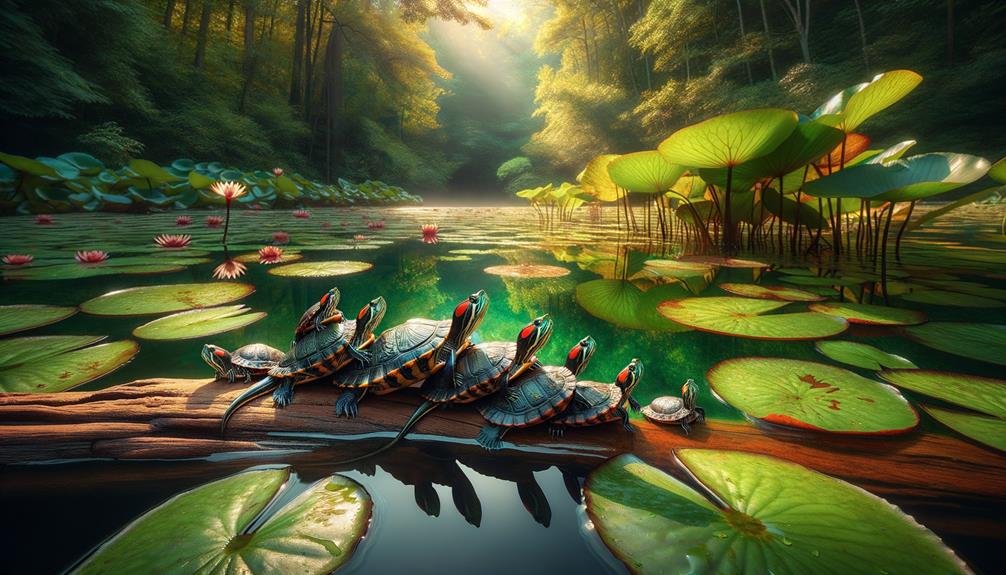The Aldabra giant tortoise is an intriguing example of an ancient endemic species that has been around for millions of years. Once widespread across the Indian Ocean islands, they have managed to survive extinction events that wiped out other giant tortoises. As a keystone species, they play a crucial role in shaping their ecosystems by dispersing seeds and reducing fire risks through grazing. The majority of the population can be found on the Aldabra Atoll, but conservation efforts have led to their reintroduction on other islands. Despite facing threats such as habitat loss and climate change, meticulous reintroduction projects aim to increase their numbers. To understand their critical ecological role and conservation strategies, it's essential to learn more about these incredible creatures.
Key Takeaways
Aldabra giant tortoises have a rich history that spans millions of years, indicating their ancient origins. Initially, they inhabited many Indian Ocean islands, but today they primarily call Aldabra Atoll home. As keystone species, they play a vital role in seed dispersal and maintaining plant populations. Conservation efforts are underway, focusing on reintroduction programs to sustain and increase their populations. However, these tortoises face significant threats, including habitat loss, invasive species, poaching, and climate change.
Historical Significance
The Aldabra giant tortoise lineage, with its ancient history spanning millions of years, holds profound historical significance. Once widespread across numerous Indian Ocean islands, this tortoise played a crucial role in shaping the ecosystems it inhabited. As a keystone species, its presence was essential for maintaining ecological balance on these islands. The tortoise's seed dispersal activities had a significant impact on plant population dynamics, ensuring the health of various plant species.
The story of the Aldabra giant tortoise is also one of resilience in the face of widespread extinction. While other giant tortoise species on islands like Mauritius became extinct, the Aldabra tortoise persisted, maintaining a stable population on the isolated Aldabra Atoll. The extinction of its counterparts led to significant ecological changes, making the preservation of the Aldabra tortoise even more critical. The historical significance of this species encompasses not just its ancient lineage but also its enduring impact on island ecosystems over the years. Conservation efforts today focus on reintroducing this species to its former habitats, restoring lost ecological functions and emphasizing its enduring legacy.
Habitat and Range
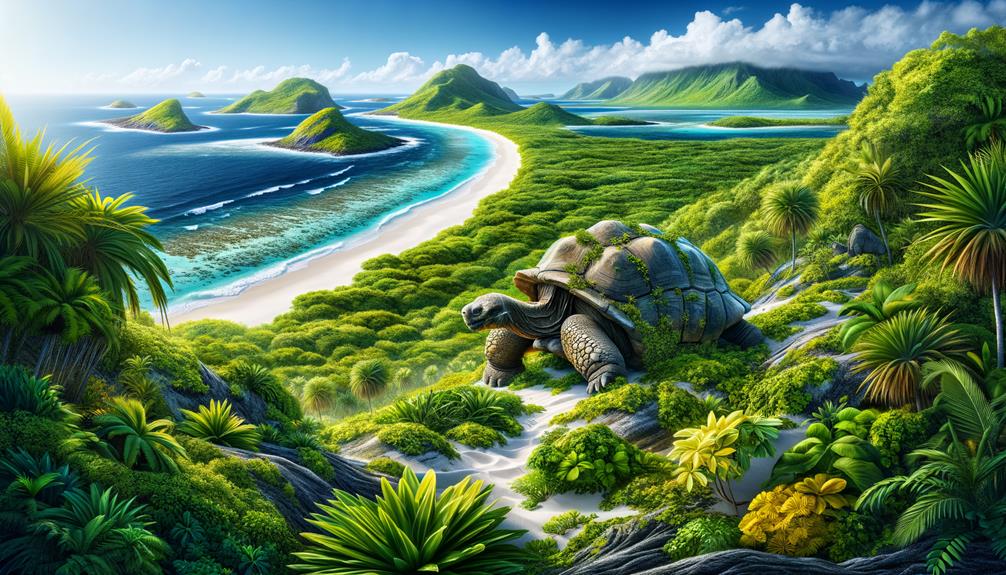
The Aldabra giant tortoise thrives in the diverse habitats of the remote Aldabra Atoll, including grasslands, low scrub, mangrove swamps, and coastal dunes. This isolated group of coral islands in the Seychelles archipelago, located in the Western Indian Ocean, forms a unique island ecosystem where these ancient reptiles have flourished for centuries. As the largest remaining population of Aldabra giant tortoises, the atoll's estimated 152,000 individuals benefit from the protection afforded by its status as a UNESCO World Heritage Site.
These tortoises are native to Aldabra Atoll, but smaller populations have also been established on other Seychellois islands, such as Fregate and Sainte Anne Marine National Park. Additionally, an isolated population exists on Changuu Island near Zanzibar. Conservation efforts have introduced captive-bred tortoises to protected areas in Mauritius and Rodrigues, enhancing their survival prospects.
The varied habitats of Aldabra Atoll allow the Aldabra giant tortoise to occupy diverse ecological niches. This adaptability highlights the species' resilience, but their preservation remains crucial, given the fragility of island ecosystems in the Indian Ocean.
Ecological Role
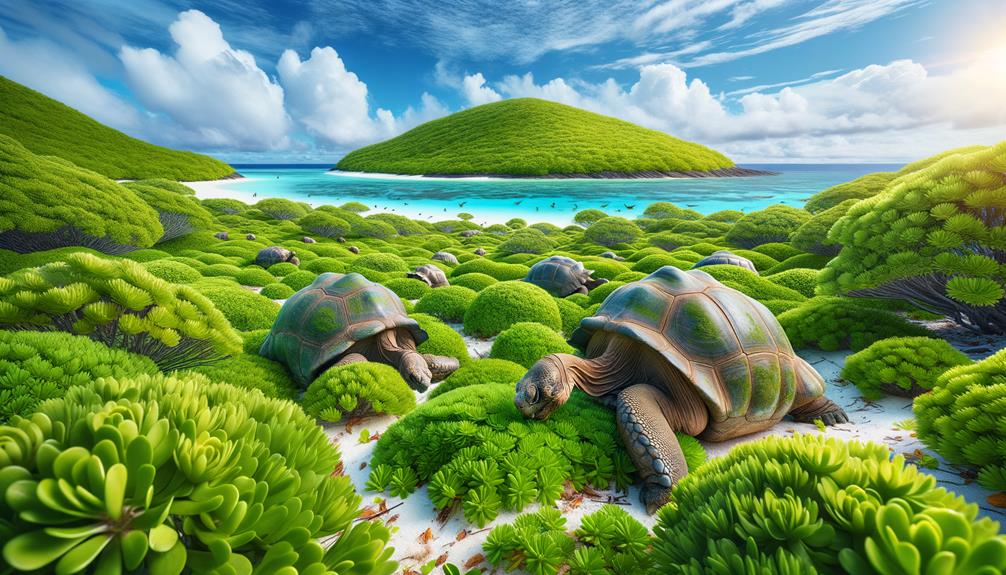
Understanding the ecological role of Aldabra giant tortoises reveals their vital function as ecosystem engineers, crucial for maintaining the biodiversity and health of the Aldabra Atoll. These gentle giants shape the very landscape they inhabit, influencing the structure and composition of vegetation through their methodical grazing. This, in turn, leads to the development of the unique tortoise turf – a complex mosaic of over 20 grass and herb species adapted to the tortoises' feeding habits.
The Aldabra giant tortoise plays a vital role in seed dispersal, similar to the ecological functions once performed by now-extinct megafauna. By consuming and excreting seeds, they ensure the propagation of various plant species, thereby maintaining the floral diversity of their ecosystem. Additionally, their grazing helps mitigate fire risks by reducing the accumulation of dry leaves and grass, effectively acting as natural firebreaks and preserving the balance between wooded and open areas.
The loss of these keystone species would result in far-reaching consequences throughout the Aldabra ecosystem, highlighting the importance of rigorous conservation efforts. Their role as ecosystem engineers is pivotal, underpinning the ecological equilibrium of the atoll.
Reintroduction Efforts
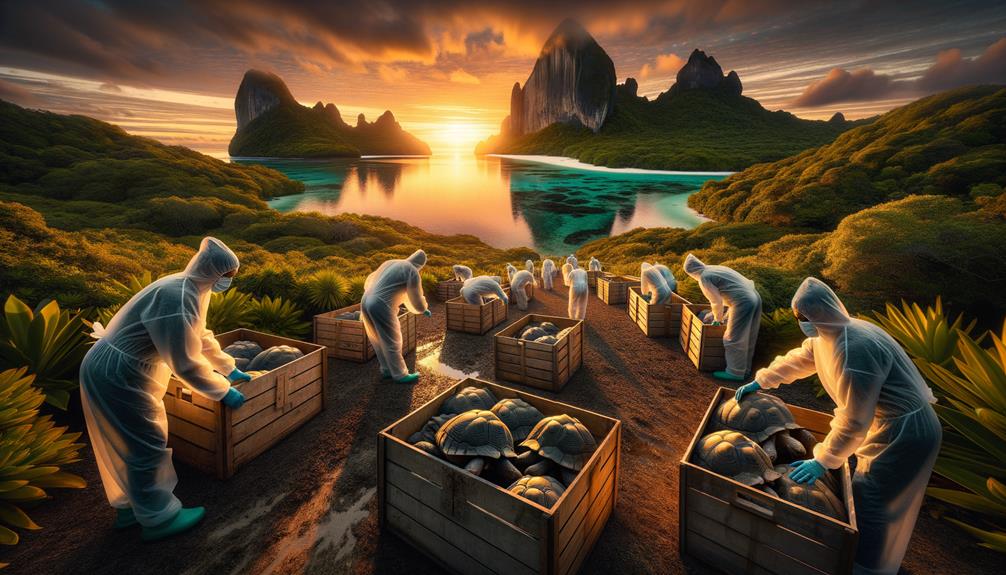
Initiated in 2018, the reintroduction of Aldabra giant tortoises to Madagascar's Anjajavy Reserve marks a significant step in restoring their historic range and enhancing local biodiversity. This ambitious project began with the reintroduction of 12 tortoises, comprising five males and seven females. Over the first five years, the population has grown, with 152 hatchlings born, underscoring the project's early success. By 2030, the aim is to establish a population of 500 wild Aldabra giants, expanding to 2,000 by 2040.
This initiative is a joint effort between various conservation organizations and academic institutions, with crucial funding from South Africa's National Research Foundation and Cirad. These partnerships are vital for the project's success, providing the necessary resources for ongoing monitoring and management.
The reintroduction is not just about numbers; the Aldabra giant tortoises are expected to play a crucial ecological role by controlling the spread of fires through their grazing activities. While initial efforts faced fewer challenges than anticipated, continuous monitoring is essential to understand their long-term impacts on the Anjajavy Reserve ecosystem. The success of this project could serve as a model for future reintroduction efforts globally.
Conservation Challenges
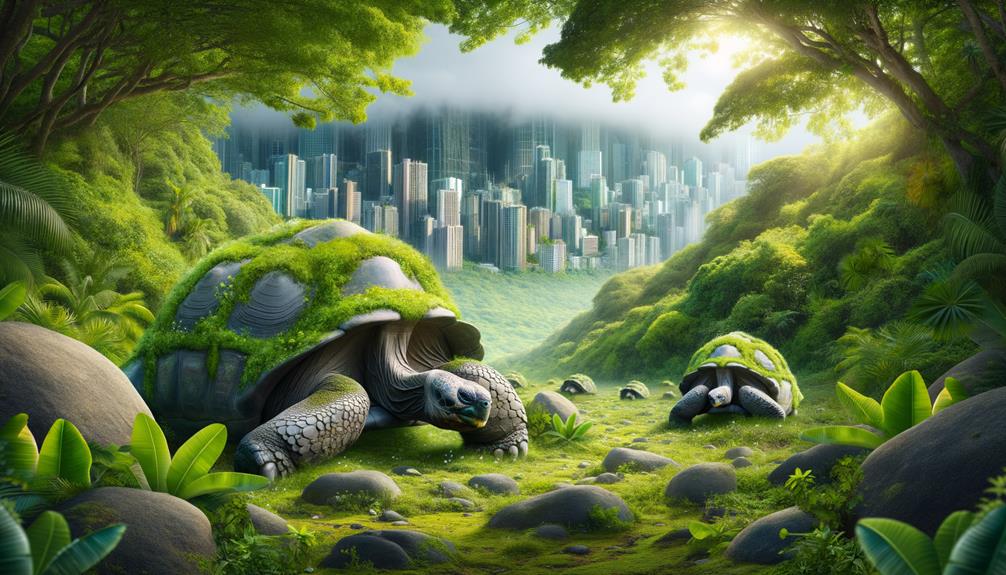
The conservation of Aldabra giant tortoises faces significant hurdles. Historical overexploitation and ongoing threats like invasive species, illegal poaching, and climate change impacts have led to a dramatic decline in their population. Once widespread across the western Indian Ocean, these species of giant tortoise are now at risk due to habitat loss and hunting.
Today, giant tortoises are threatened by invasive predators and climate change, which puts their low-lying Aldabra Atoll habitat at risk from rising sea levels. The slow reproductive rate of females, who lay only 9-25 eggs every 2-3 years, makes population recovery a lengthy and challenging process. The current population's genetic diversity is also a concern, as it likely descended from a severe bottleneck event in the late 19th or early 20th century, making reintroduction efforts difficult to verify.
To protect Aldabra tortoises, meticulous planning and long-term monitoring are essential. Without addressing these challenges, the conservation status of these ancient endemics remains precarious, highlighting the need for sustained conservation efforts.
Frequently Asked Questions
Where Are Aldabra Tortoises Native To?
Aldabra tortoises are native to the remote Aldabra Atoll in the Seychelles, and they represent a unique evolutionary lineage. This atoll provides a critical habitat for the largest population of these ancient creatures, with an estimated 152,000 individuals living there.
Is the Giant Tortoise Endemic?
The giant tortoise is indeed endemic to certain regions, with an impressive 90% of its population residing in its native habitat. These remarkable creatures have evolved in isolation, significantly contributing to our understanding of island biogeography.
What Is the Oldest Living Aldabra Tortoise?
The oldest living Aldabra tortoise is Esmeralda, who is currently 179 years old as of 2022. Her remarkable longevity provides a unique window into the past, highlighting the resilience and ancient lineage of these incredible creatures.
Why Is the Aldabra Tortoise Endangered?
The Aldabra tortoise is endangered due to historical overhunting and habitat destruction. A severe population decline in the late 19th century also weakened the species. Despite conservation efforts, the tortoise remains vulnerable to ongoing threats like habitat degradation and invasive species, which continue to jeopardize its survival.


